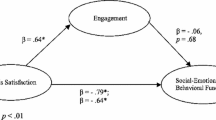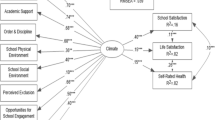Abstract
This study investigated the relationships among school satisfaction, social support, and problem behaviors in adolescents. Modest associations were found between school satisfaction and the demographic variables of gender, race, age, and grade level. Support from teachers, parents, and classmates contributed unique variance to ratings of school satisfaction; with teacher support contributing the most unique variance. School satisfaction mediated the relationship between social support and internalizing and externalizing behaviors. School satisfaction did not moderate the relationship between social support and problem behavior; however, it did serve as a protective factor across all levels of social support. Implications are discussed, including suggestions for developing interventions that focus on increasing support for adolescents in efforts to improve school satisfaction and reduce problem behaviors.
Similar content being viewed by others
References
Achenbach, T. M. (1991). Manual for the child behavior checklist/4-18 and 1991 profile. Burlington, VT: University of Vermont, Department of Psychiatry.
Baker, J. A. (1998). The social context of school satisfaction among urban, low-income African-American students. School Psychology Quarterly, 13, 25–44.
Baker, J. A. (1999). Teacher–student interaction in urban at-risk classrooms: Differential behavior, relationship quality, and student satisfaction with school. Elementary School Journal, 100, 57–70.
Baron, R. M., & Kenny, D. A. (1986). The moderator–mediator variable distinction in social psychology research: Conceptual, strategic, and statistical considerations. Journal of Personality and Social Psychology, 51, 1173–1182.
Bronfenbrenner, U. (1979). The ecology of human development. Cambridge, MA: Harvard University Press.
Collishaw, S., Maughan, B., Goodman, R., & Pickles, A. (2004). Time trends in adolescent mental health. Journal of Child Psychology and Psychiatry, 45, 1350–1362.
Demaray, M. K., & Malecki, C. K. (2002a). Critical levels of perceived social support associated with student adjustment. School Psychology Quarterly, 17, 213–241.
Demaray, M. K., & Malecki, C. K. (2002b). Measuring perceived social support: Development of the Child and Adolescent Social Support Scale (CASSS). Psychology in the Schools, 39, 1–18.
Dryfoos, J. (1990). Adolescents at risk. New York: Oxford Press.
Eamon, M. K. (2002). Influences and mediators of the effect of poverty on young adolescent depressive symptoms. Journal of Youth & Adolescence, 31, 231–242.
Epstein, J. (1981). Patterns of classroom participation, student attributes, and achievements. In J. Epstein (Ed.), Quality of school life (pp. 81–116). Lexington, MA: Heath.
Epstein, J., & McPartland, J. M. (1976). The concept and measurement of the quality of school life. American Educational Research Journal, 13, 15–30.
Evans, D. R. (1994). Enhancing quality of life in the population at large. Social Indicators Research, 33, 47–88.
Fallon, B. J., & Bowles, T. V. (1997). The effects of family structure and family functioning on adolescents’ perceptions of intimate time with parents, siblings, and peers. Journal of Youth and Adolescence, 26, 25–43.
Fredrickson, B. L. (2001). The role of positive psychology: The broaden-and-build theory of positive emotions. American Psychologist, 56, 218–226.
Fredrickson, B. L., & Joiner, T. (2002). Positive emotions trigger upward spirals toward emotional well-being. Psychological Science, 13, 172–175.
Gilman, R., Huebner, E. S., & Laughlin, J. (2000). A first study of the Multidimensional Students’ Life Satisfaction Scale with adolescents. Social Indicators Research, 52, 135–160.
Harter, S. (1985). Manual for the social support scale for children. Denver: University of Denver.
Hawkins, M. W., & Fraser, J. D. (1984). The social networks of opioid abusers. International Journal of the Addictions, 19, 903–917.
Hirsch, B. J., & Rapkin, B. D. (1987). The transition to junior high school: A longitudinal study of self-esteem, psychological symptomatology, school life, and social support. Child Development, 58, 1235–1243.
Huebner, E. S. (1994). Preliminary development and validation of a multidimensional life satisfaction scale for children. Psychological Assessment, 6, 149–158.
Huebner, E. S., Ash, C., & Laughlin, J. E. (2001). Life experiences, locus of control, and school satisfaction in adolescence. Social Indicators Research, 55, 167–183.
Huebner, E. S., Laughlin, J. E., Ash, C., & Gilman, R. (1998). Further validation of the Multidimensional Students’ Life Satisfaction Scale. Journal of Psychoeducational Assessment, 16, 118–134.
Huebner, E. S., & McCullough, G. (2000). Correlates of school satisfaction among adolescents. Journal of Educational Research, 93, 331–335.
Karatzias, A., Power, K. G., Flemming, F., Lennan, F., & Swanson, V. (2002). The role of demographics, personality variables and school stress on predicting school satisfaction/dissatisfaction: Review of the literature and research findings. Educational Psychology, 22, 33–50.
Karatzias, A., Power, K. G., & Swanson, V. (2001). Quality of school life: Development and preliminary standardization of an instrument based on performance indicators in Scottish secondary schools. School Effectiveness and School Improvement, 12, 265–284.
Ladd, G. W., Buhs, E. S., & Seid, M. (2000). Children’s initial sentiments about kindergarten: Is school liking an antecedent of early classroom participation and achievement? Merrill-Palmer Quarterly, 4, 255–279.
Larson, R., & Richards, M. H. (1991). Daily companionship in late childhood and early adolescence: Changing developmental contexts. Child Development, 62, 284–300.
Licitra-Kleckler, D. M., & Waas, G. A. (1993). Perceived social support among high-stress adolescents: The role of peers and family. Journal of Adolescent Research, 8, 381–402.
Lifrak, P. D., McKay, J. R., Rostain, A., Alterman, A., & O’Brien, C. P. (1997). Relationship of perceived compentencies, perceived social support, and gender yo substance abuse in young adolescents. Journal of the American Academy of Child Adolescent Psychiatry, 36, 933–940.
Malecki, C. K., & Demaray, M. K. (2002). Measuring perceived social support: Development of the child and adolescent social support scale (CASSS). Psychology in the Schools, 39, 1–18.
McKnight, C. G., Huebner, E. S., & Suldo, S. M. (2002). Relationships among stressful life events, temperament, problem behavior, and global life satisfaction in adolescents. Psychology in the Schools, 39, 677–687.
Mok, M. C., & Flynn, M. (2002). Determinants of students’ quality of school life: A path model. Learning Environments Research, 5, 275–300.
Okun, M. A., Braver, M. W., & Weir, R. M. (1990). Grade level differences in school satisfaction. Social Indicators Research, 22, 419–427.
Ostander, R., Weinfurt, K. P., & Nay, W. R. (1998). The role of age, family support, and negative cognitionos in the prediction of depressive symptoms. School Psychology Review, 27, 121–137.
Reynolds, C. R., & Kamphaus, R. W. (1992). Behavior assessment system for children (BASC). Circle Pines. MN: American Guidance Services.
Rosenfeld, L. B., & Richman, J. M. (1999). Supportive communication and school outcomes, Part II: Academically “at-risk” low income high school students. Communication Education, 48, 294–307.
Rosenfeld, L. B., Richman, J. M., & Bowen, G. L. (2000). Social support networks and school outcomes: The centrality of the teacher. Child and adolescent Social Work Journal, 17, 205–226.
Sobel, M. E. (1982). Asymptotic intervals for indirect effects in structural equations models. In S. Leinhart (Ed.), Sociological methodology (pp. 290–f312). San Francisco: Jossey-Bass.
Suldo, S. M., & Huebner, E. S. (2004a). The role of life satisfaction in the relationship between authoritative parenting dimensions and adolescent problem behavior. Social Indicators Research, 66(1–2), 165–195.
Suldo, S. M., & Huebner, E. S. (2004b). Does life satisfaction moderate the effects of stressful life events on psychopathological behavior during adolescence? School Psychology Quarterly, 19, 93–105.
Tardy, C. (1985). Social support measurement. American Journal of Community Psychology, 13, 187–202.
U.S. Department of Education, National Center for Education Statistics. (2005a). Special analysis 2005, Mobility in the teacher workforce: What does the teacher workforce look Like?, NCES 2005-114. Washington, DC: U.S. Government Printing Office. Retrieved June 1, 2006 from http://nces.ed.gov/programs/coe/2005/analysis/sa01.asp.
U.S. Department of Education. National Center for Education Statistics. (2005b). The condition of education, 2005, NCES 2005-094. Washington, DC: U.S. Government Printing Office.
Verkuyten, M., & Thijs, J. (2002). School satisfaction of elementary school children: The role of performance, peer relations, ethnicity and gender. Social Indicators Research, 59, 203–228.
White, K. S., Bruce, S. E., Farrell, A. D., & Kliewer, W. (1998). Impact of exposure to community violence on anxiety: A longitudinal study of family social support as a protective factor for urban children. Journal of Child & Family Studies, 7, 187–203.
Author information
Authors and Affiliations
Corresponding author
Rights and permissions
About this article
Cite this article
DeSantis King, A.L., Huebner, S., Suldo, S.M. et al. An Ecological View of School Satisfaction in Adolescence: Linkages Between Social Support and Behavior Problems. Applied Research Quality Life 1, 279–295 (2006). https://doi.org/10.1007/s11482-007-9021-7
Received:
Accepted:
Published:
Issue Date:
DOI: https://doi.org/10.1007/s11482-007-9021-7




